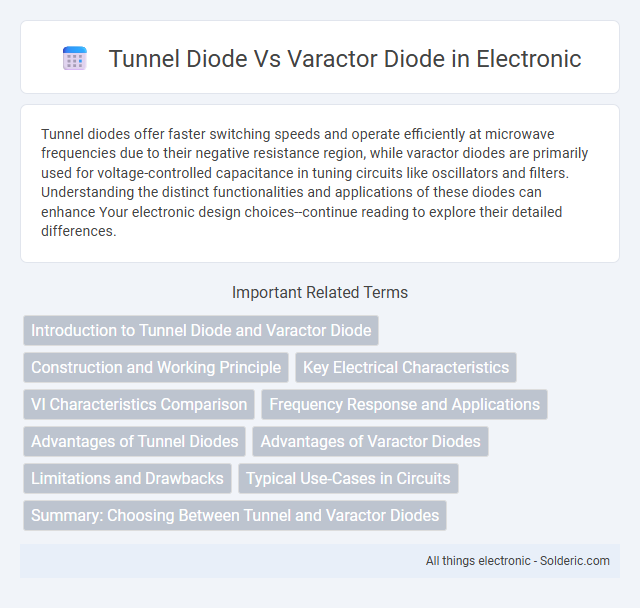Tunnel diodes offer faster switching speeds and operate efficiently at microwave frequencies due to their negative resistance region, while varactor diodes are primarily used for voltage-controlled capacitance in tuning circuits like oscillators and filters. Understanding the distinct functionalities and applications of these diodes can enhance Your electronic design choices--continue reading to explore their detailed differences.
Comparison Table
| Feature | Tunnel Diode | Varactor Diode |
|---|---|---|
| Function | Fast switching, negative resistance device | Voltage-controlled capacitance device |
| Operating Principle | Quantum tunneling effect | Variable junction capacitance |
| Typical Use | High-frequency oscillators and amplifiers | Tuning circuits in RF and microwave systems |
| Voltage Characteristics | Negative differential resistance region | Reverse-biased, varies capacitance with voltage |
| Speed | Extremely high-speed operation | Moderate speed, frequency tuning |
| Material | Heavily doped semiconductor (e.g., GaAs) | Heavily doped PN junction diode |
| Applications | Microwave oscillators, amplifiers | Voltage-controlled oscillators, frequency modulators |
Introduction to Tunnel Diode and Varactor Diode
Tunnel diodes are semiconductor devices characterized by their negative resistance region, enabling high-speed switching and oscillations in microwave frequency applications. Varactor diodes function as voltage-controlled capacitors, exploiting the variable depletion region width under reverse bias to tune frequency in oscillators and filters. Both diodes serve unique roles in RF and microwave circuits due to their distinct electrical behaviors.
Construction and Working Principle
Tunnel diodes are constructed with heavily doped p-n junctions, creating a thin depletion region that enables quantum mechanical tunneling, allowing current to flow at very low voltages. Varactor diodes, also known as varicap diodes, utilize a reverse-biased p-n junction where the depletion region width varies with applied voltage, effectively changing the diode's capacitance. Tunnel diodes operate based on the tunneling effect for high-speed switching, while varactor diodes function as voltage-controlled capacitors in RF tuning circuits.
Key Electrical Characteristics
The Tunnel diode exhibits negative resistance due to quantum tunneling, enabling high-speed switching with peak current and valley current defining its operating region. Varactor diodes function as voltage-controlled capacitors, with capacitance inversely proportional to the reverse bias voltage, making them ideal for frequency tuning applications. Your choice depends on whether you require ultra-fast switching (Tunnel diode) or variable capacitance for voltage-controlled oscillators (Varactor diode).
VI Characteristics Comparison
Tunnel diodes exhibit a unique VI characteristic with a region of negative resistance caused by quantum mechanical tunneling, allowing them to operate at extremely high speeds and frequencies. In contrast, varactor diodes display a nonlinear capacitance that varies with reverse bias voltage, reflected in their VI curve as a typical diode reverse-bias region without negative resistance. This difference makes tunnel diodes suitable for high-frequency oscillators and amplifiers, while varactor diodes are primarily used in voltage-controlled capacitors for frequency tuning applications.
Frequency Response and Applications
Tunnel diodes exhibit extremely fast frequency response in the microwave and millimeter-wave ranges due to their negative resistance region, making them ideal for high-frequency oscillators and amplifiers in radar and communication systems. Varactor diodes, with voltage-dependent capacitance, are widely used for frequency tuning in RF circuits, voltage-controlled oscillators (VCOs), and phase-locked loops (PLLs) where precise frequency control is essential. Your choice between these diodes will depend on whether you require high-speed switching and oscillation (Tunnel diode) or tunable capacitance for frequency modulation (Varactor diode).
Advantages of Tunnel Diodes
Tunnel diodes offer ultra-fast switching speeds and high-frequency operation due to their negative resistance region, making them ideal for microwave and high-speed oscillators. Their low power consumption and high reliability under extreme conditions enhance performance in specialized applications where conventional diodes fail. Tunnel diodes also exhibit excellent noise resistance, contributing to their use in sensitive electronic circuits and communication systems.
Advantages of Varactor Diodes
Varactor diodes offer superior voltage-controlled capacitance, enabling precise tuning in RF circuits and voltage-controlled oscillators (VCOs). Their low noise and high Q-factor enhance signal quality and frequency stability, making them ideal for communication systems and phase-locked loops. You benefit from efficient frequency modulation and miniaturized designs due to their compact size and reliable performance in varying voltage conditions.
Limitations and Drawbacks
Tunnel diodes face limitations such as low output power and high susceptibility to noise, which restrict their use in high-frequency applications. Varactor diodes exhibit nonlinear capacitance response and limited voltage range, impacting their performance in tuning circuits. Both devices require careful biasing to avoid distortion and maintain operational stability.
Typical Use-Cases in Circuits
Tunnel diodes are commonly used in high-frequency oscillators and microwave amplification circuits due to their negative resistance region enabling fast switching and low noise. Varactor diodes serve as voltage-controlled capacitors in tuning and frequency modulation applications, such as phase-locked loops, RF filters, and voltage-controlled oscillators. Both diodes are essential in RF and microwave engineering but differ in function: tunnel diodes for amplification and oscillation, varactors for frequency tuning and voltage-dependent capacitance.
Summary: Choosing Between Tunnel and Varactor Diodes
Tunnel diodes excel in high-speed switching and microwave frequency applications due to their negative resistance region, making them ideal for oscillators and amplifiers. Varactor diodes function primarily as voltage-controlled capacitors, essential in tuning circuits such as voltage-controlled oscillators and frequency modulators. Selecting between tunnel and varactor diodes depends on the application requirements for either high-speed switching or voltage-controlled capacitance adjustments.
Tunnel diode vs Varactor diode Infographic

 solderic.com
solderic.com